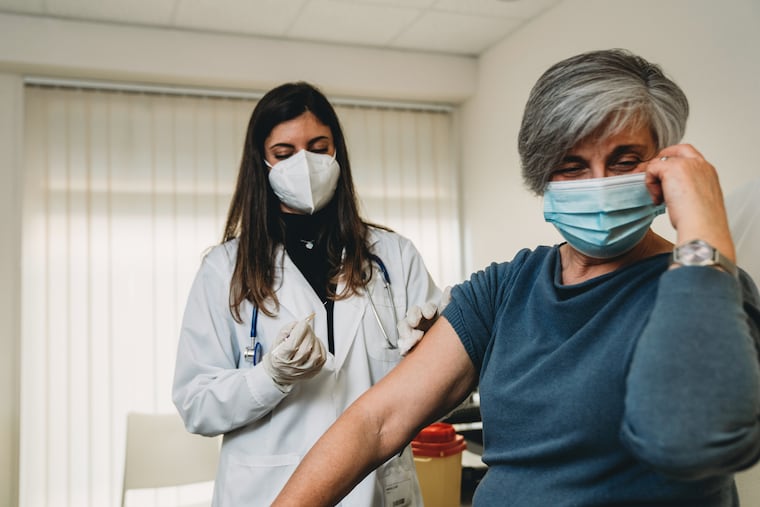A fear of needles or injections may keep some from COVID-19 vaccine. This treatment can help.
There’s a serious problem that gets overlooked when we talk about “vaccination hesitancy”: Many adults are perfectly willing to get vaccinated, but are simply very afraid of shots.

As many people as possible need to get their COVID-19 vaccinations in the coming months. This will protect them from a potentially deadly virus and help us to reach herd immunity as quickly as possible, limiting further outbreaks.
But there’s a serious problem that gets overlooked when we talk about “vaccination hesitancy”: Many adults have confidence in the vaccine itself, but are terrified of getting a shot. They may make all sorts of excuses for why they are delaying or refusing, but secretly, they avoid because they fear pain, puncture, or fainting during administration. Research shows that 3% to 5% of adults meet criteria for blood-injection phobia and that about 10% have significant needle fears.
Many who avoid needle jabs report nausea and fainting before, during, or after medical procedures. These occur because the physical response to the fear of blood and needles differs from that to, say, fear of dogs or snakes. In blood-injection phobia, there is initially the typical fear response of panicked fight-or-flight, with a rapid heart rate and spike in blood pressure. For the unlucky minority who inherited it, there is then a second, more dramatic, reflex where heart rate and blood pressure fall. This is called an exaggerated vasovagal response that can result in nausea and sometimes a temporary loss of consciousness.
As a result, those with strong blood-injection fears understandably avoid — or endure with panic and dread:
Potentially life-saving injections, vaccinations, blood draws, and surgeries.
Routine doctors’ and dentists’ visits for check-ups and preventative care, which can be life-saving, as well.
Pursuing jobs in health-care-related fields, becoming pregnant, or accompanying loved ones to medical procedures.
Common misperceptions of blood-injection phobias are that the sufferers are whiny babies who should just get over it. But fainting is a reflex; not a choice. Another is that there is no treatment for feeling faint at the sight of a needle or blood and that this is just something one has to live with, a myth popularized by medical television shows such as M*A*S*H.
Or sufferers dread that any treatment for blood-injection fears will involve years on a therapist’s couch, discussing one’s feelings about needles, in the vague hope that this will somehow bring about a miraculous change. (It will not. Want proof? If processing “I hate it; it’s uncomfortable; I dread it,” hour after hour actually worked, then we would all be getting the 150 minutes of weekly exercise currently recommended by the CDC).
The truth is that we have a well-researched and mercifully brief psychological treatment for blood-injection fears called exposure therapy with — for the fainters — Applied Tension. Exposure therapy and applied tension for adults and children work in as little as one to five sessions. During applied tension, individuals are trained to recognize the physical symptoms of an impending fainting response, or even the situational cues that predict impending difficulty, such as “I have to visit the doctor” or “I have to read a news article about vaccinations.”
They are then trained to tense large muscle groups, which brings about an increase in blood pressure, which prevents nausea and fainting. Finally, exposure therapists will help a patient practice this tension technique in applied settings, such as while watching videos of injections or attending blood draws and vaccination appointments.
Exposure therapy with applied tension, as delivered by a specialist in cognitive-behavioral therapy (CBT) is highly effective: In a 2018 study of blood-injection-injury fearful adults, 70% completed a successful blood draw after one session. The main difficulty is finding a qualified therapist to deliver the treatment, as only 10% to 30% of therapists incorporate exposure practices into their work with individuals with anxiety disorders and fewer have experience with exposure-based therapy for blood-injection phobias.
There are good online resources for finding cognitive-behavioral therapists. The Society of Clinical Psychology has a web page of excellent descriptions of exposure therapy for different kinds of phobias that have been supported by research. Consumers can read this to educate and empower themselves, then interview therapists on how many blood-injection fearful patients they have treated and what specific interventions they used before committing to treatment.
Katherine K. Dahlsgaard, PhD, ABPP is a licensed psychologist in private practice and board certified in Behavioral and Cognitive Psychology.